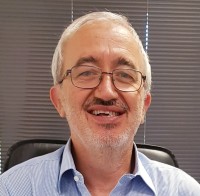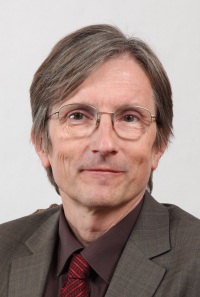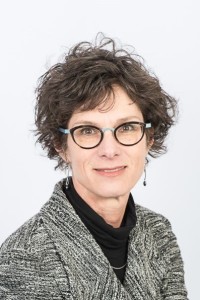ECCOMAS Multibody Dynamics Conference 2019
July 15-18, 2019, Duisburg, Germany
Keynote Lectures
Monday, 15.07.19, 8:30 - 9:15 h Keynote 1: Alberto Cardona

Alberto Cardona
Professor, Universidad Nacional del Litoral, Santa Fe, Argentina
The nonsmooth generalized-α method for flexible and rigid multibody system dynamics
(Alberto Cardona, Javier Gálvez, Federico Cavalieri, Alejandro Cosimo and Olivier Brüls)
Abstract:
The aim of this work is the development of methods for the numerical simulation of the nonsmooth dynamics of multibody systems involving rigid and/or flexible elements which can be subject to frictionless contacts and impacts. These systems are characterized by bilateral constraints which are associated to kinematic joints interconnecting the bodies, and by unilateral constraints stemming from the frictionless contacts and impacts. An additional difficulty comes from the presence of flexible elements, with vibration effects that need to be efficiently captured by the numerical scheme.
For the robust and accurate simulation of such systems, special attention must be paid to the adopted time integration scheme as it not only has to deal successfully with the nonsmooth character of the problem but also with the vibration effects. Time integrators for nonsmooth dynamics can be classified in two main groups: event-driven and time-stepping integrators. The former are based on the exact detection of impacts by accordingly adapting the time step size. However, they become inefficient in situations involving a large number of impact events. A different strategy is adopted in this work, which falls under the category of timestepping integrators. These techniques share the common feature that the time step size does not need to be adapted to impact events. The most widespread time-stepping integrators for nonsmooth dynamical systems are the Schatzman–Paoli scheme [1, 2], which is based on a central difference scheme, and the Moreau–Jean scheme [3, 4, 5], which is based on a q-method. Despite their robustness for dealing with problems involving a large number of impacts, they generally lead to poor approximations of vibration phenomena. Additionally, in the Moreau–Jean scheme, the constraints are only imposed at velocity level which leads to the violation of the constraints at position level and, in consequence, a drift phenomenon is observed [6].
These problems have been studied in the literature of nonsmooth dynamics, mainly dealing with the use of higher order integrators for the smooth or free-flight part of the motion [6, 7, 8, 9, 10], and with the simultaneous imposition of the constraints at position and at velocity levels [11, 12, 6]. The imposition of the constraints at acceleration level was also analyzed recently by Brüls et al. [10]. The current work takes as starting point the nonsmooth generalized-a (NSGA) introduced by Brüls et al. in [6] and proposes a modification to improve its robustness for problems with nonlinear bilateral constraints and/or flexible components.
The NSGA deals with the transient simulation of nonsmooth dynamical systems comprised of rigid and/or flexible bodies, kinematic joints and frictionless contacts. It is characterized by the splitting of the involved fields into a smooth and a (nonsmooth) impulsive contribution, where the former is integrated with second order accuracy by means of the generalized-a scheme and the latter with first-order accuracy. Also, the involved unilateral and bilateral constraints are exactly satisfied both at position and at velocity levels. This results in a numerical scheme which involves three coupled subsets of equations or sub-problems to be solved at each time step: one for the smooth prediction of the motion, and two others for correcting that prediction at position and at velocity levels with the nonsmooth contributions. The existing coupling stems from the adopted splitting in which the smooth sub-problem depends on the position correction and on the velocity jump. Therefore, if a semi-smooth Newton approach is used to solve the derived formulation without making any additional assumption, at each nonlinear iteration the method would have to deal monolithically with the complete set of unknowns. In order to avoid this issue, Brüls et al. [6] proposed to neglect the terms coupling the smooth sub-problem with the other ones from the tangent matrix. The advantage of this procedure is that the algorithm can be described as a sequence of three sub-problems, instead of having to solve the complete set of equations monolithically. This approximation is fully justified when the adopted step size tends to zero. However, for problems with flexible bodies and nonlinear bilateral constraints, this approximation led to a slow convergence of the global scheme, or even to the divergence of the scheme if a small enough step size was not adopted. In order to overcome this difficulty, the current work proposes to modify the way to do the splitting in order to ensure a full decoupling of the different subsets of equations, so that the three sub-problems can be processed in a sequential decoupled manner without any approximation. Here, the adjective decoupled is used because the resulting numerical scheme involves the sequential solution of three sub-problems without neglecting any term in the discrete problem. This implies that the proposed decoupled scheme results in a robust alternative especially for problems characterized by nonlinear bilateral constraints and flexible elements.
Examples of application to impacts with and without friction, and also simultaneous impact problems with rigid and flexible bodies are presented.
[1] Paoli, L., and Schatzman, M., 2002. “A numerical scheme for impact problems I: The one-dimensional case”. SIAM Journal on Numerical Analysis, 40(2), pp. 702–733.
[2] Paoli, L., and Schatzman, M., 2002. “A numerical scheme for impact problems II: The multidimensional case”. SIAM Journal on Numerical Analysis, 40(2), pp. 734–768.
[3] Jean, M., and Moreau, J. J., 1987. “Dynamics in the presence of unilateral contacts and dry friction: A numerical approach”. In Unilateral Problems in Structural Analysis — 2. Springer Vienna, pp. 151–196.
[4] Moreau, J. J., 1988. “Unilateral contact and dry friction in finite freedom dynamics”. In Nonsmooth Mechanics and Applications. Springer Vienna, pp. 1–82.
[5] Jean, M., 1999. “The non-smooth contact dynamics method”. Computer Methods in Applied Mechanics and Engineering, 177(3-4), pp. 235–257.
[6] Brüls, O., Acary, V., and Cardona, A., 2014. “Simultaneous enforcement of constraints at position and velocity levels in the nonsmooth generalized-alpha scheme”. Computer Methods in Applied Mechanics and Engineering, 281, pp. 131 – 161.
[7] Chen, Q., Acary, V., Virlez, G., and Brüls, O., 2013. “A nonsmooth generalized-a scheme for flexible multibody systems with unilateral constraints”. International Journal for Numerical Methods in Engineering, 96(8), pp. 487–511.
[8] Schindler, T., and Acary, V., 2014. “Timestepping schemes for nonsmooth dynamics based on discontinuous galerkin methods: Definition and outlook”. Mathematics and Computers in Simulation, 95, pp. 180–199.
[9] Schindler, T., Rezaei, S., Kursawe, J., and Acary, V., 2015. “Half-explicit timestepping schemes on velocity level based on time-discontinuous galerkin methods”. Computer Methods in Applied Mechanics and Engineering, 290, pp. 250–276.
[10] Brüls, O., Acary, V., and Cardona, A., 2018. “On the constraints formulation in the nonsmooth generalized-a method”. In Advanced Topics in Nonsmooth Dynamics. Springer International Publishing, pp. 335–374.
[11] Acary, V., 2013. “Projected event-capturing time-stepping schemes for nonsmooth mechanical systems with unilateral contact and coulomb’s friction”. Computer Methods in Applied Mechanics and Engineering, 256, pp. 224–250.
[12] Schoeder, S., Ulbrich, H., and Schindler, T., 2013. “Discussion of the gear-gupta-leimkuhler method for impacting mechanical systems”. Multibody System Dynamics, 31(4), pp. 477–495.
Biography:
Alberto Cardona earned a degree in mechanical engineering from Universidad Nacional de Rosario, Argentina in 1980, and a PhD from University of Liege, Belgium, in 1989. He is currently full professor at Universidad Nacional del Litoral, Argentina, and researcher at Conicet. He is director of the Research Center of Computational Methods, Santa Fe, Argentina.
Alberto Cardona specialized in multibody dynamics and participates in the Editorial Committees of several scientific journals. He is Fellow of the International Association for Computational Mechanics. He co-authored the book “Flexible Multibody Dynamics: A Finite Element Approach” and more than ninety papers in international journals. He co-founded a software company in computational mechanics, which commercializes and develops the software Oofelie. His research interests include modeling in flexible multibody dynamics, contact mechanics, nonlinear heat transfer, reduction methods and computational welding.
Tuesday, 16.07.19, 8:30 - 9:15 h Keynote 2: Gabor Stepan

Gabor Stepan
Department of Applied Mechanics
Budapest Unviersity of Technology and Economics
Non-smooth bifurcations in delayed tyre models of wheel shimmy
Abstract:
Shimmy is still a hard-to-predict vibration phenomenon of towed rolling wheels. Although it appears on vehicles with low probability, it may cause serious accidents on aircrafts, articulated buses, trailers, jeeps, motorcycles, bicycles, even on wheel-chairs and baby strollers. Brief introduction to low degree-of-freedom models of shimmying wheels is presented first for rigid wheels supported by elastic structures, then for wheels of elastic tyres with rigid suspension. The first group of models assume single contact point and Coulomb friction. Local and global dynamic analyses explore parameter regions with bistability, isola, chaotic and transient chaotic oscillations and the need for the extension of the idea of Filippov systems is also explained. If there is a pneumatic tyre on the wheel, the wheel is modelled to be soft relative to the supporting structure. In these cases, industry uses the classical creep force theory to predict wheel shimmy, which provides satisfactory results in most of the cases. However, a certain time delay effect becomes relevant in the corresponding brush or stretched-string-like tyre models especially at low and high towing speeds. The stability charts obtained by linear stability analysis present various bifurcation phenomena. These are checked by experiments on a test rig and also by numerical simulation. Double Hopf bifurcations leading to quasi-periodic oscillations are identified and the so-called micro-shimmy is also explored as a phenomenon where the small-amplitude tyre oscillations lead to increased heat, noise and as a consequence, to increased fuel consumption. The experimentally detected bifurcation phenomena of micro-shimmy can be modelled and explained by carrying out a non-smooth bifurcation analysis that is related to the nonlinear effect of partial slipping within the tyre/ground contact region.
Biography:
Gabor Stepan is professor in Applied Mechanics at Budapest University of Technology and Economics (BME), in Hungary, a position that he has since 1995. His research interests include nonlinear vibrations and time-delay systems with specific applications in mechanical engineering, like nonlinear dynamics of elastic wheels, vibrations and stability of robots, force control, stabilization of unstable equilibria, human and robotic balancing, rehabilitation robotics, machine tool vibrations, traffic dynamics, hardware-in-the-loop experiments.
He has been on the editorial board of Nonlinear Dynamics, Mechanism and Machine Theory, Physica D. He is member of the Hungarian Academy of Sciences and the Academy of Europe. He is ERC Advanced Grant holder (2014-2019) and the recipient of the Thomas K. Caughey Dynamics Award of ASME (2015). Between 1995 and 2018, Prof Gabor Stepan was the head of the Department of Applied Mechanics at BME, also served as the dean of the Faculty of Mechanical Engineering (2008-2012). He is presently an elected member of the Executive Committee of the Congress Committee of IUTAM, he has been recently elected to serve as a member in the Euromech Council.
Wednesday, 17.07.19, 8:30 - 9:15 h Keynote 3: John McPhee

John McPhee
Systems Design Engineering
University of Waterloo, Canada
morg.uwaterloo.ca
Multibody dynamics and model-based control of biomechatronic systems
Abstract:
In the Motion Research Group at the University of Waterloo (morg.uwaterloo.ca), we investigate the dynamics, model-based control, and design optimization of multibody systems. Deriving the equations for complex biomechatronic systems is tedious and error-prone, so we have automated the dynamic modelling process by combining linear graph theory from mathematics with fundamental principles from physics, chemistry, and biology. Our symbolic computer implementation, now part of MapleSim™, will generate real-time simulation code and dynamic controllers for systems ranging from exoskeletons to autonomous vehicles.
In this talk, I will discuss the real-time dynamics and model-predictive control of biomechatronic systems, with an emphasis on applications that include assistive robotics, user-tailored electric power steering for Toyota, and optimal performance in golfing and cycling; in all cases, unified dynamic models of the human and their equipment are used to determine optimal control actions. Symbolic computing is used to create real-time model-based controllers, and experiments are used to validate the models and demonstrate the controller performance. I will also discuss our current research to combine math-based models with machine learning, with applications to markerless motion capture, the Waterloo autonomous car (Autonomoose), and an environment recognition system for exoskeleton users.
Biography:
John McPhee is a Professor and Canada Research Chair in System Dynamics at the University of Waterloo, which he joined in 1992. Prior to that, he held research fellowships at Queen’s University, Canada, and the Université de Liège, Belgium.
McPhee’s research is focused on the multibody dynamics, control, and optimization of biomechatronic systems, with applications to assistive robotics, autonomous driving, and sports engineering. His research partners include Toyota, Maplesoft, Intellijoint Surgical, the Canadian Space Agency, Cycling Canada, Magna, Ping Golf, and the Canadian Sports Institute.
Prof. McPhee is the past Chair of the International Association for Multibody System Dynamics and a co-founder of 2 journals and 3 international technical committees. He provides editorial duties for 6 leading journals in his field, and has had the pleasure of supervising nearly 100 graduate students and postdoctoral fellows.
McPhee is a Fellow of the Canadian Academy of Engineering, the American Society of Mechanical Engineers, the Engineering Institute of Canada, and the Canadian Society of Mechanical Engineers. He has won 5 Best Paper Awards and, in 2014, he received the prestigious NSERC Synergy Award from the Governor-General of Canada.
Thursday, 18.07.19, 8:30 - 9:15 h Keynote 4: Janet Ronsky

Janet L Ronsky, PhD., P.Eng., FCAE
Mechanical & Manufacturing Engineering,
Schulich School of Engineering, Faculty of Kinesiology, Cumming School of Medicine, University of Calgary
Multi-modal approaches to advance insights in aberrant knee joint biomechanics
Abstract:
Understanding the movement dynamics of human joints is critical for evaluating injury and disease conditions, enhancing physical performance and designing technologies to assist or improving healthy and impaired movement. Similar to man-made machines, human joints undergo millions of cycles of loading over the lifespan. However maintaining health in musculoskeletal biomaterials, unlike inert materials, involves the tissue’s ability to continuously adapt its structure and biology to its mechanical loading environment. While key biomechanical factors have been linked to degenerative joint conditions, the initiating biomechanical mechanisms are still not well established. Understanding and quantifying the mechanical loading environment within human joints and joint tissues remains a key challenge. Various non-invasive and invasive approaches have been employed over time to estimate the multi-joint “rigid body” dynamics of the musculoskeletal system, with varying degrees of accuracy, cost and utility. This presentation will describe novel state-of-the-art integrated imaging and 3D modelling approaches based on high-speed biplanar videoradiography that provide segment kinematics with sub-millimeter accuracy, and enable new insights into human joint movement dynamics, cartilage contact patterns, as well as cartilage structure and composition. The importance of segment and joint coordinate system selection and approaches, as well as data analysis techniques will be explored. Applications and challenges in healthy and degenerated knee joints will be discussed.
Biography:
Janet Ronsky is a Professional Engineer and holds the Alberta Innovates iCORE Strategic Chair in Advanced Diagnostics and Devices. She is a Full Professor in the Schulich School of Engineering, Kinesiology, and Cumming School of Medicine at the University of Calgary. Janet holds a BASc in Mechanical Engineering (Waterloo University) and a PhD in Mechanical Engineering (University of Calgary). She is an elected Fellow of the Canadian Academy of Engineers, serves on CIHR Grant review panels, and was the NSERC Mechanical Engineering Group Chair (2014-2017). Her research focuses on understanding links between musculoskeletal structure, joint mechanics, dynamic joint function, neuromotor control, and joint injuries and diseases. Medical imaging, experimental and numerical modeling approaches are applied to develop novel diagnostic and treatment techniques to enhance health care. She is responsible for the Clinical Movement Assessment and Dual Fluoroscopy Laboratories at the McCaig Institute for Bone and Joint Health. Janet founded the Centre for Bioengineering Research and Education at the University of Calgary. She currently directs Zymetrix Biomaterials and Tissue Engineering Technology Development Centre. Holding several patents, she has developed innovative technologies relating to medical imaging, joint dynamics and materials testing.







